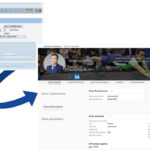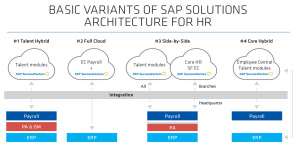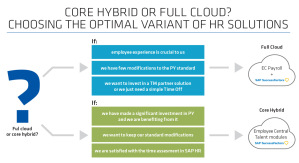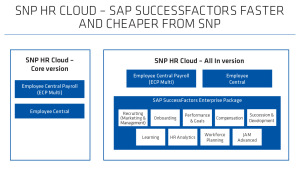It will be easier to understand SAP’s HR offering if we trace how it has changed over time. The SAP HR system appeared in the product portfolio in 1986. 15 years later, it was complemented by self-service applications (ESS/MSS), E-Learning and E-Recruiting. Until 2011, not much changed apart from the emergence of the SAP NetWeaver technology platform as well as the SAP ERP and SAP Business Suite 7 integrated packages. For HR, these were not revolutions and it can be said that the current on-premise installations do not differ significantly from those from a dozen or so years ago.
The real change came in 2011 when SAP purchased SuccessFactors, then the second largest cloud solution after salesforce.com, with 6,000 customers and 32 million users in 185 countries. In 2012, the manufacturer announced that it planned to migrate HR to the cloud and in the future all functionalities, including payroll, would be offered in a subscription model. Companies still had two options to choose from — on-premise (SAP ERP HR) and SAP SuccessFactors.
SAP launched an intensive campaign to encourage customers (13,000 organizations) to migrate HR equivalents to the cloud, however “equivalent" is not meant literally here, as SuccessFactors has a completely different philosophy and assumptions behind it.
Employee experience
First, it is a completely different user experience. Those customers who worked with the “old" SAP HR, in SAP GUI, will appreciate the difference in the interface. This is also the first time that the term “employee experience” is used in the context of SAP solutions. SuccessFactors meets the new paradigm defined by the acronym ACE: Availability to everyone, Consumer grade technology, Employee needs first. ACE is a slogan promoted by Jacob Morgan as a benchmark for HR technology.
Since 2013, customers have had the option of technology-assisted migrations. This is not a 1:1 transfer of functionalities but a change – a shift toward standardization and best practices. Talent management modules have a completely new look in SuccessFactors. Upon deciding to migrate to SF, you have to rethink the issue of working time. In SF Employee Central, the handling of working time is simplified and it supports the management of administrative employees with simple schedules. Therefore, companies with complex working time processes (working time planning and evaluation) are recommended by SAP to purchase a complementary product offered by partners. We offer our customers All for One E-Time with SAP-Qualified Partner-Packaged Solution for SAP SuccessFactors certification.

User interface in SAP HR (SAP GUI) and in SuccessFactors
Architecture variants for HR
As some customers have extensive SAP HR on-premise environments and are not ready for a complete migration for various reasons, since 2013 SAP has been supporting three basic architecture variants: on-premise, talent hybrid and full cloud.
In the ‘talent hybrid’ model, the employee record system (a place of recording of the employee’s master data) is SAP ERP HR, while in SuccessFactors, talent management processes are handled. It is currently a very popular model because it does not require re-implementation of the hard part of HR.
Due to the rather slow adoption of cloud solutions in the market, SAP postponed the end date of standard SAP HR support from 2015 to 2020 and then to 2025.

Michał Szymaczek, HCM Manager, All for One Poland
In 2014, another architectural option appeared – side-by-side, and in 2015 – core hybrid. To put it simply, the side-by-side variant is based on an approach that changes depending on a branch or group company. For example, in the headquarters, the SAP HR system is used as the leading system, and talent management is carried out in SuccessFactors, while in the selected branches, SF Employee Central is the master system. Payroll accounting can be performed in an on-premise system or other local application, depending on the company. The side-by-side variant is used especially during the merger or digitalization of HR processes of individual companies in the group. In small steps, a corporation can migrate to the cloud. In the side-by-side variant, SF Employee Central can be a consolidating system and at the same time the master system for selected branches. For those branches for which the master system is SAP ERP HR, the data is replicated to SF EC. This variant is quite complicated in terms of configuration due to the frequent lack of standardization of processes and data in the group (e.g. different lists of values and processes).

The core-hybrid variant changes a lot in handling HR processes. The employee is not hired in SAP ERP HR but in SuccessFactors. In the on-premise system, payroll (and possibly time evaluation) is calculated, however to make this possible, most of the data is automatically replicated from SF to the relevant HR infotypes. Only data specific to the payroll portion (e.g. IT0413, IT0515…) is stored in the payroll system. According to the manufacturer’s assumptions, many core-hybrid projects are to lead to full migration to the cloud in the long run. The core-hybrid architecture is a temporary state, giving customers time to prepare for the migration of payroll to SF EC Payroll.
So which variant (core-hybrid or full-cloud) is optimal?
Let’s look at the figure below. If we answer yes to the questions on the left and no to those on the right, the path is simple – full migration to the cloud. However, it is not always so easy and the challenge requires deeper analysis.

In these considerations, one more important aspect must be taken into account – the period of standard support for individual variants. But more on that in a moment.
Transitional variant of SAP HCM for S/4HANA
In 2019, SAP announced one more variant to be added to the already complex puzzle – SAP HCM for S/4HANA. This (on-premise) system, with planned availability in Q3 2022, is intended to be a bridge giving customers additional time to migrate to the cloud. The upgrade to SAP HCM for S/4HANA will be a migration supported by standard tools. Customers who opt for this scenario will need to convert their licenses, however at present (November 2020) we do not yet know the new terms and conditions.
SAP HCM for S/4HANA is expected to have the same scope as SAP ERP HR but without the recruitment and soft features. The exception is SAP Learning Solution, presumably due to the scale of usage by organizations. The system will be based on SAP HANA DB and will be optimized for SAP HANA (with the possibility of running on the same or a separate S/4HANA instance). The guaranteed period of support is crucial – until 2040!
Time to migrate to the cloud
SAP ERP HR and hybrid variants will be supported in the standard mode until the end of 2027 (with the option of several years of extended support for a higher fee).
Let’s summarize the current offering of SAP. In the HR area, we have two systems: SAP ERP HR (on-premise) and SAP SuccessFactors (cloud), with the standard support period for the former ending in 2027. SuccessFactors is the target HR solution offered by SAP – this is where investments and innovations will be made. As of today, customers have seven years to migrate to the cloud unless they opt for higher maintenance costs beyond 2027 and no developmental changes to their systems.
SAP has about 12,000 HR customers, of which nearly 4,000 use SuccessFactors applications in various architectural variants. We estimate that at least 7,000-8,000 organizations may decide to migrate to the cloud in this fairly short seven-year period. This is good news for SAP partners, but it is also a signal to organizations not to delay their migration plans, as demand for migration project support services may at some point be much higher than supply.
The migration process itself is a time-consuming project. However, there are SAP tools available to support migration (e.g. Infoporter). Also SNP (now All for One Poland) offers a package of tools to accelerate and facilitate the transition process in the Bluefield model using the CrystalBridge data transformation platform.
When planning the future of the HR system in an organization, decision makers should take into account the fact that in line with the direction of development in SAP, innovations will only appear in the SAP SuccessFactors solution. An additional advantage of the cloud model over an on-premise one is that new solutions can be made available to users very quickly, without the need to run upgrade projects.

SuccessFactors faster and cheaper
All for One HR Cloud is an option to acquire an SAP SuccessFactors subscription from SNP. In this model, customers get a pre-configured SuccessFactors system in the SAP cloud at a much more attractive price than the list price. This offer is aimed at organizations with up to 5,000 employees and includes two variants: “Core" (SF EC and EC Payroll) and “All-in" (the entire SF package). In this model, the system will be ready to go live faster and at a lower cost, based on pre-configured processes.

